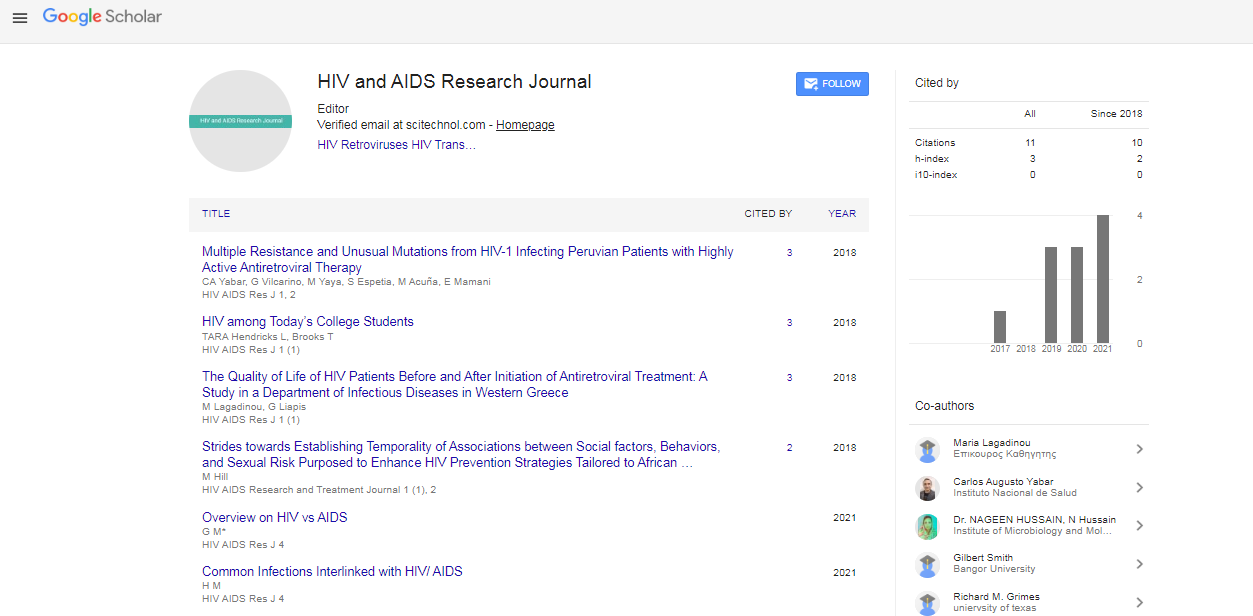Commentary, Hiv Aids Res J Vol: 4 Issue: 3
Transmission of HIV: Short Notes
Steinberg S*
Department of medical sciences, Institute of Toronto, Canada
*Corresponding Author: Steinberg S Department of medical sciences, Institute of Toronto, Canada ,E-Mail: Steinbergss23@tr.mded.cn
Received: 05 November, 2021; Accepted: 19 November, 2021; Published: 26 November, 2021
Keywords: HIV-positive, offspring, mucus lining
Introduction
HIV is spread through the exchange of infected people's blood and other body fluids, breast milk, sperm, and vaginal secretions. Throughout pregnancy and birth, a mother's HIV can be passed on to her child. Individual people cannot become infected through normal daily contact, such as kissing, touching, holding hands, or sharing personal items, food, or water. It is significant to mention that HIV patients who are on ART and are virally suppressed do not transmit HIV to their sexual partners. Instant access to ART and support to stay on diagnosis are thus critical not just for improving the lives of people living with HIV but also for preventing Spread of HIV. The most common forms with which this disease is transmitted in most countries around the world are as follows; Sharing infusion syringes with the other drug addicts and patients who already are likely to be HIV positive, among health professionals who might inadvertently prick themself with just a diseased needle. The danger is incredibly low, before or even during birth, from an infected parent to offspring. All through breastfeeding, transmission may also occur through breast milk. The transmission rate is low if the mother is taking anti-HIV medications, Through the use of HIV-infected blood transfusions. These days, blood is tested for HIV before even being given blood, so this is extremely rare, having a medical operation performed with unsanitary equipment that might be used on HIV-positive people. Being exposed to a diseased person's blood, organs, or products. It is a frequent thing among health professionals, those who get tattoos or have their bodies pierced using shared syringes or improperly sterilised devices. The pathogens can infect a person's bloodstream through cuts as well as lesions in the skin, the thin innermost layer on or within the anus, penis, or vagina, and the mucus lining of the eyes and mouth.
HIV infection is not transmitted by Touch, hugs, kissing, healthy skin with unbroken contact, sneezed on the other infected persons face, sharing of regular items like towels, food, washrooms, and cutlery, it can spread via saliva of infected persons this is the rare symptom and very fragile and it does not live outside the body. Having unprotected anal or vaginal sex; having some other sexual disease (STI) such as syphilis, herpes, chlamydia, gonorrhoea, and bacterial vaginitis; sharing infected syringes, syringes, as well as other injection drug users tools and drug solutions when injecting drugs; having received unsafe infusions, blood products, as well as tissue organ transplants; and surgical treatments that are involving in unsterile cuts and piercing and accidental needles which is using to other persons.
Rapid medical tests that would provide same-day results could be used to make a diagnosis HIV. This greatly simplifies timely detection and connection to care and support. HIV self-tests can be used to test individuals. Even so, no single test could provide a complete HIV diagnosis; confirmative testing at a community hall or clinic by an educated and skilled health or community working person is needed. HIV infection can be identified with high precision using WHO-approved tests in conjunction with a nationally approved testing strategy.
 Spanish
Spanish  Chinese
Chinese  Russian
Russian  German
German  French
French  Japanese
Japanese  Portuguese
Portuguese  Hindi
Hindi 